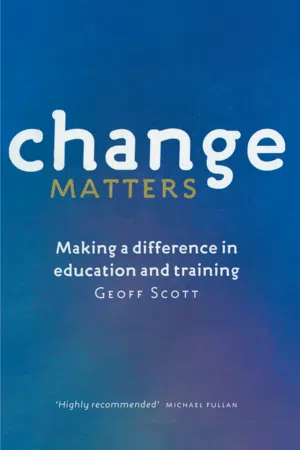
- 256 pages
- English
- ePUB (mobile friendly)
- Available on iOS & Android
About This Book
While many books address the 'what' of change in education, this addresses the 'how'. The pressure for continuous adaptation and innovation in education is relentless, yet there is more failure in implementation of change than success. These failures are damaging to staff and students, as well as costly. Change Matters offers a practical guide to change management for teachers and administrators across all education sectors and for training managers in workplace settings. Change Matters assists educators to develop their abilities to manage their own change projects, and also to help their organisations to manage their overall improvement and innovation activities. Geoff Scott draws on successful experience to create a framework for the educational change process. He shows how to initiate, develop, implement and evaluate a new learning program, and how to manage continuous quality improvement and innovation at the organisational level. The need for leadership is assessed, and the particular circumstances of workplace trainers are discussed. The book is illustrated with case studies and reflective exercises which can be used individually or with other educators.'An eminently readable and practical guide for those who want to make sure that the educational changes they attempt really do make a difference for their students. Highly recommended.' - Professor Michael Fullan, Dean, Ontario Institute for Studies in Education, University of Toronto, and author of The New Meaning of Educational Change and of the What's Worth Fighting For trilogy with Andy Hargreaves.
Frequently asked questions
Information
1 HOW THE CHANGE PROCESS IN EDUCATION WORKS
THE DYNAMICS OF CHANGE: EDUCATORS' CHANGE ANALOGIES
Educators' Change Analogies
- guide;
- coach;
- director of a play;
- chef in a restaurant;
- potter;
- surfboard rider on the waves of change;
- person negotiating a swamp;
- skipper on an ocean-going yacht;
- World War II general;
- person having a baby;
- swimmer in a tidal pool;
- mechanic trying to fix a car while it is going 100 kph;
- whitewater rafter;
- father confessor;
- juggler balancing spinning plates on the end of sticks;
- person in an Escher drawing.
- crew member;
- member of a chorus line;
- fellow traveller;
- person learning to cook for themselves;
- collector;
- creature in metamorphosis;
- piece of clay being moulded;
- person all at sea;
- bouncing ball;
- person on an icy slide;
- person going up a down escalator.
- What, in general terms, are these analogies telling us about the nature of the change process in education?
- How and why do these analogies vary?
- Either select the analogy from the list that best matches your current experience of the change process in education or make up a new one.
- Briefly write down how your selected analogy works and why it best describes your experience. For example, what does it say about the nature of the change process for someone in your position?
- How might your role (for example, as teacher, admin istrator, manager etc.) and the amount of experience you have had in that job influence the sort of analogy chosen?
- Compare and contrast your results with the summary of research on the nature of the change process in education in the following section.
Research on the dynamics of change
Is uncertain
Operates in phases
Is cyclical not linear
Is composed of a mix of factors beyond and within one's control
Is reciprocal
Requires educators who can 'read and match'
Change management myths
- The knight on a white charger myth All that is necessary is to appoint a dynamic, reform-oriented leader and successful change is assured.
- The consensual myth A proposed change will only work if everyone it affects has approved of it; that is, a 'bottom up' approach to change always works,,
- The lineal' myth Change proceeds in a fixed, one-off, linear fashion from initiation through development, implementa tion and institutionalisation.
- The brute logic myth Change is achieved by brute logic; that is, provided the proponent's argument for a change is compelling, those it affects will automatically adopt it.
- The change event myth Change is an event, like the launch of a new policy or curriculum rather than being a long iterative learning (and unlearning) process for all its par ticipants.
- The silver bullet myth There is a set procedure which, if followed, will guarantee successful change.
- The one size fits all myth All that is necessary is to develop a standardised, 'teacher proof curriculum or procedure and users will implement it fully and exactly as intended in every location ac...
Table of contents
- Cover
- Title Page
- Copyright Page
- Contents
- Tables and figures
- Acknowledgments
- Introduction
- 1 How the change process in education works
- 2 Managing change in learning programs
- 3 Managing workplace improvement in education
- 4 Workplace research for continuous improvement and innovation
- 5 The effective leader of change
- 6 Looking outwards and forwards in education
- Conclusion
- Glossary
- Notes
- References
- Index